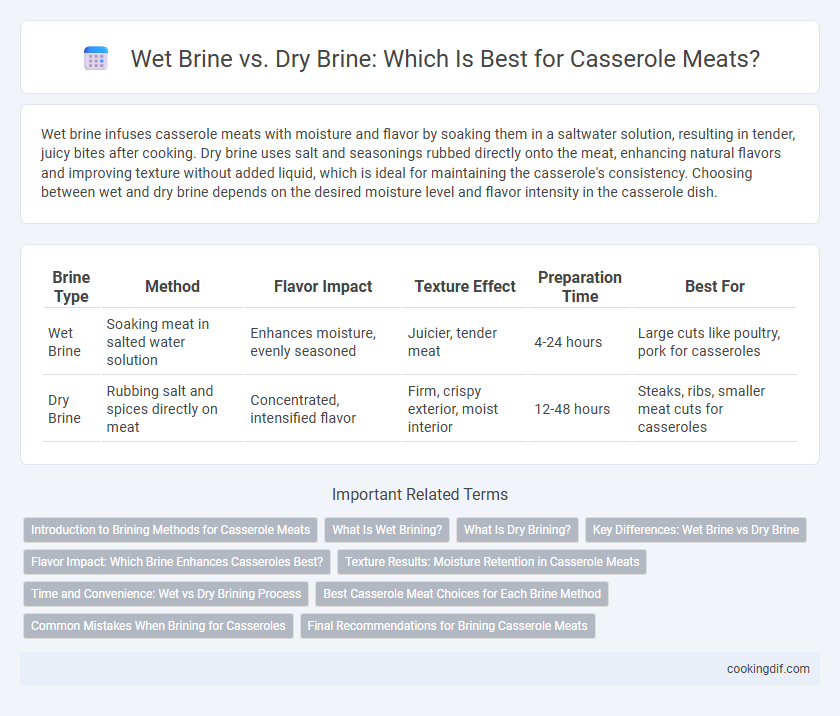Wet brine infuses casserole meats with moisture and flavor by soaking them in a saltwater solution, resulting in tender, juicy bites after cooking. Dry brine uses salt and seasonings rubbed directly onto the meat, enhancing natural flavors and improving texture without added liquid, which is ideal for maintaining the casserole's consistency. Choosing between wet and dry brine depends on the desired moisture level and flavor intensity in the casserole dish.
Table of Comparison
| Brine Type | Method | Flavor Impact | Texture Effect | Preparation Time | Best For |
|---|---|---|---|---|---|
| Wet Brine | Soaking meat in salted water solution | Enhances moisture, evenly seasoned | Juicier, tender meat | 4-24 hours | Large cuts like poultry, pork for casseroles |
| Dry Brine | Rubbing salt and spices directly on meat | Concentrated, intensified flavor | Firm, crispy exterior, moist interior | 12-48 hours | Steaks, ribs, smaller meat cuts for casseroles |
Introduction to Brining Methods for Casserole Meats
Wet brine involves soaking casserole meats in a saltwater solution, enhancing moisture retention and tenderness by allowing salt to penetrate deeply. Dry brine uses a salt rub directly applied to the meat's surface, drawing out juices that then reabsorb with concentrated flavors, improving texture and seasoning. Both methods optimize meat juiciness and flavor, crucial for rich, succulent casserole dishes.
What Is Wet Brining?
Wet brining involves soaking casserole meats in a saltwater solution infused with herbs and spices, which helps to retain moisture and enhance flavor during cooking. This method increases the meat's juiciness by allowing the salt to penetrate deeply, breaking down muscle proteins and improving texture. Wet brining is particularly effective for tougher cuts, making them tender and succulent when baked in casseroles.
What Is Dry Brining?
Dry brining involves rubbing salt and seasonings directly onto casserole meats, allowing the salt to absorb moisture and enhance flavor without adding extra liquid. This method intensifies the meat's natural juices and improves texture by promoting even seasoning distribution and moisture retention during cooking. Compared to wet brining, dry brining results in a more concentrated taste and a better caramelized crust in casserole dishes.
Key Differences: Wet Brine vs Dry Brine
Wet brine involves soaking casserole meats in a saltwater solution, which enhances moisture retention and results in juicier texture, while dry brine uses a salt and seasoning rub directly on the meat, concentrating flavors and improving crust development. Wet brining can add extra moisture but may dilute the meat's natural flavor, whereas dry brining intensifies flavor by drawing out and then reabsorbing the meat's juices. For casserole dishes, dry brining often leads to more robust taste and better texture retention under baking conditions compared to wet brining.
Flavor Impact: Which Brine Enhances Casseroles Best?
Wet brine infuses casserole meats with deep, evenly distributed moisture and salt, enhancing tenderness and juiciness. Dry brine concentrates flavors by drawing out and reabsorbing the meat's natural juices, resulting in a more intense and savory taste profile. For casseroles, wet brine suits recipes requiring a succulent texture, while dry brine maximizes bold, robust flavor complexity.
Texture Results: Moisture Retention in Casserole Meats
Wet brine enhances casserole meat texture by increasing moisture retention through saltwater absorption, resulting in juicier and more tender dishes. Dry brine draws out natural juices that reabsorb over time, intensifying flavor and slightly firming the meat's texture. Both methods improve casserole meat moisture, but wet brine typically delivers a more consistently moist and succulent outcome.
Time and Convenience: Wet vs Dry Brining Process
Wet brining involves submerging casserole meats in a saltwater solution typically for 4 to 12 hours, enabling faster moisture absorption but requiring refrigeration and space. Dry brining, using a salt rub applied directly to the meat, takes longer--often 12 to 24 hours--but offers greater convenience with less mess and no need for a container. Choosing between wet and dry brining impacts preparation time and kitchen logistics, making dry brining preferable for easy, hands-off seasoning and wet brining suitable for quicker, intensive moisture infusion.
Best Casserole Meat Choices for Each Brine Method
Wet brine is ideal for lean meats like chicken breast or turkey, as it retains moisture and ensures a juicy casserole outcome. Dry brine suits fattier cuts such as pork shoulder or beef brisket, enhancing flavor concentration without adding excess water. Choosing the right brine method depends on meat type to optimize tenderness and taste in casseroles.
Common Mistakes When Brining for Casseroles
Common mistakes when brining meats for casseroles include over-salting in wet brines, which can make the meat overly salty and affect the dish's balance. Failing to evenly distribute a dry brine results in inconsistent seasoning and uneven moisture retention, leading to dry or tough casserole meats. Ignoring proper brining times also causes either insufficient flavor infusion or overly mushy textures, compromising the casserole's overall quality.
Final Recommendations for Brining Casserole Meats
For casserole meats, wet brine enhances moisture retention and tenderness by allowing even salt penetration through immersion, ideal for poultry and pork. Dry brine intensifies flavor and improves texture by drawing out juices that reabsorb with seasoning, best suited for beef and smaller cuts. Choose wet brine for juicier casseroles and dry brine to maximize robust, concentrated meat flavors in your dish.
Wet brine vs dry brine for casserole meats Infographic

 cookingdif.com
cookingdif.com